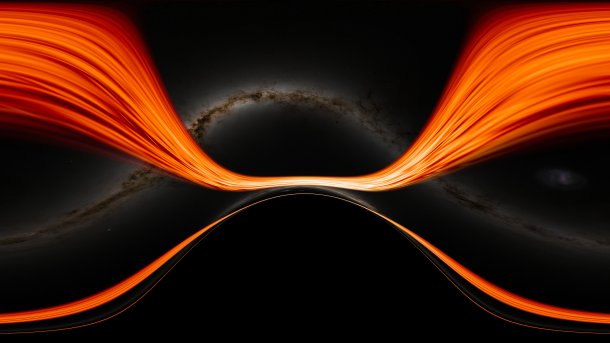‘Bizarre effects’: NASA visualisation shows fall into giant black hole
Black holes are not only unattainable for us, but also difficult to imagine. Several NASA visualizations now show what we would see there.

The perspective during a fly-by
(Bild: NASA's Goddard Space Flight Center/J. Schnittman and B. Powell)
NASA has published a series of visualizations to help us understand what we would see if we were to fall into a supermassive black hole or even narrowly escape it. The visualizations were created using a supercomputer from the US space agency. The project generated around 10 terabytes of data.
The videos show how the perspective of the immediate surroundings of the black hole and the rest of the universe literally bends as it approaches and how everything is finally swallowed up by blackness. A 360-degree view is also available on YouTube, in which you can decide for yourself where the camera should be aimed.
Empfohlener redaktioneller Inhalt
Mit Ihrer Zustimmmung wird hier ein externes Video (Kaltura Inc.) geladen.
Ich bin damit einverstanden, dass mir externe Inhalte angezeigt werden. Damit können personenbezogene Daten an Drittplattformen (Kaltura Inc.) übermittelt werden. Mehr dazu in unserer Datenschutzerklärung.
The virtual journey begins around 640 million kilometers away from a black hole with a mass of around 4.3 million solar masses, which is roughly the size of Sagittarius A* at the center of the Milky Way. A flat ring of hot, glowing gas racing around the object serves as a guide, writes NASA. In real time, the fall to be tracked would take around three hours, during which the camera would continue to accelerate towards the speed of light. For an external observer, however, it would never reach the event horizon with a diameter of 25 million kilometers, but would freeze beforehand, so to speak. Not even light can escape from behind the event horizon.
Bizarre consequences of Einstein's formulas
During the virtual flight, the views of the Milky Way and the dust disk become increasingly distorted, the back becomes the front, the top becomes the bottom. Once the event horizon has been crossed, it would take less than 13 seconds until the final destruction through so-called spaghettification, explains NASA. This is the term used when black holes pull so much harder on one end of objects than the other that it ultimately drags them out. However, the US space agency also explains that a supermassive black hole is preferable to a much smaller one for such an approach. There, strong tidal forces would cause such destruction much earlier.
The visualizations make various effects visible that follow from Albert Einstein's theory of relativity. Those responsible at NASA speak of "bizarre" consequences resulting from the formulas. If you only come close to the black hole during such a flight, they explain that the person in question would age more slowly compared to those in a more distant spaceship. However, if the black hole rotates quickly - like the one in the movie "Interstellar" – this difference would be years. To illustrate this, there is a visualization that only shows the respective times. The collection of all films can be found at NASA's Scientific Visualization Studio.
(mho)